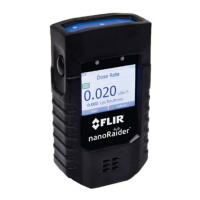3.4. Identifying a Radiation Source FLIR Detection
Figure 71. Finding the position for best measurements
The FLIR identiFINDER R300 assists with advice given on-screen (Figure 71, p. 76).
4. Wait until the preset acquisition duration is over.
The FLIR identiFINDER R300 applies the identiication algorithm to the acquired data and
shows the result (Figure 72, p. 76). Additionally, the identiication results including the spec-
trum and, if required and available, the GPS coordinates are automatically saved in the FLIR
identiFINDER R300’s database.
Figure 72. Identiication results
Nuclides the identiication algorithm did not recognize or those recognized but having
their visibility suppressed (see 6.5, p. 118) are reported as “Unknown”.
You can specify whether conidence, usage, or severity are shown, see 6.4, p. 116.
5. If necessary, you can acquire more spectrum data to improve the identiication by pressing
Continue .
76 identiFINDER
®
R300/en/2014.4(13623)/Feb2015

